Why Bucks’ Entertainment District May Fail
Across the country these mega-projects have hurt cities with generic development that banishes local charm.
Back in 2008, two professors wrote a piece for the Journal of Urban Design on “entertainment zones“ with “unplanned nightlife” arising in some cities and picked Milwaukee’s Water Street bar district as a classic and successful example. Water Street, argued professors Daniel Campo and Brent D. Ryan, is a classic example of “Entertainment zones” that are “concentrated nightlife districts occupying the margins of downtowns in former commercial and industrial areas, underutilized retail corridors or underdeveloped waterfronts.”
Ryan, a professor of urban design at MIT, had once lived in Chicago and was familiar with Milwaukee, and so he and Campo took a look at this city. “We thought it was ironic you had all these major development projects, like Grand Avenue Mall and the convention center, west of the river, and none of these places were fun to hang out in. The place that was the most fun was the area planners had forgot about.”
Water Street simply arose on its own, with no urban planning, no city subsidies, in a somewhat run-down area, developing serendipitously by taking advantage of what makes a city pop: density, diversity and proximity. “The modest buildings of north Water Street would seem an unlikely candidate for the densest concentration of bars and restaurants in the Milwaukee region,” the authors write. “Nonetheless, in 2003 the two small blocks of north Water Street and parts of two adjacent blocks contained 14 entertainment establishments. This number increased to 16 establishments by 2007… Only one building occupies more than 25% of the block frontage, and no building is more than four storeys high.”
They note that Water Street “lacks many of those design features conventionally labelled as ‘good urbanism’, such as wide sidewalks, park spaces, sidewalk cafes… signage and planting schemes,” yet “the district’s modest scale and visual variety create a lively streetscape that modern downtown development processes cannot easily replicate despite substantial subsidies and national corporate involvement.”
Indeed, the authors contrast Water Street to the more touted urban entertainment districts like Universal CityWalk (Los Angeles), Fourth Street Live (Louisville) and Centro Ybor (Tampa), which are “characterized by large size and an inward focus… usually range from 250,000 to 600,000 square feet, although newer facilities can be even larger,” and “much like casinos … are wholly contained, inward-oriented environments, designed to create and maximize a captive market.”
Their expansive size “makes them difficult to fit within existing urban street patterns and their development therefore often requires… the acquisition or condemnation of private property, or large, isolated parcels,” the study notes.
Similarly, the Milwaukee Bucks owners are creating a huge entertainment district with a far larger arena (two square blocks) than the Bradley Center and another square block or more of bars, restaurants and retail. The development will require the demolition of a city parking garage, will be created by one owner, and the bars and restaurants will largely be national chains rather than locally unique places. (The Bucks have promised the city that 25 percent will be locally owned.) This huge, tax subsidized mega-project is designed to capture every dollar spent by Bucks fans, so that none of it spins off into other parts of the city.
“I wouldn’t be surprised if it draws customers away from Water Street,” says Ryan.
Ryan says Milwaukee was lucky that both Miller Park and the Potawatomi Casino were built in the Menomonee Valley rather than in Downtown. The theory that a stadium or arena can help a downtown is largely based on older, far smaller facilities like Fenway Park or Wrigley Field, he notes. The effect of today’s mega-stadiums or arenas is “always the same” in its impact on downtowns, Ryan says: “It’s always expensive, it always gets a large public subsidy, it’s always destructive to the existing city, and it forecloses other, more interesting development that could occur.”
Ryan and Campo point to a long list of urban design researchers which have “found informality, accident and lack of unifying plans to be key factors in good urban design,” have “praised dense neighborhoods of modestly-scaled buildings” and “have argued that dwellings and cities must develop organically” and cannot be created “by centralized authority… or by master plans.’”
Besides Water Street, the city has seen successful development arise on Brady Street, in Bay View centered on S. Kinnickinnic Ave., on Milwaukee Street, and is seeing similar development on S. 2nd St. in Walker’s Point and Center Street in Riverwest and of course in the Third Ward. All of these areas are uniquely local and a lot of fun. (As for central planning, the Third Ward’s growth was helped by the neighborhood association plan and city tax incremental financing, and Second Street benefitted from a street widening, brown fields grants, etc.)
The Bucks development, by contrast, will involve zero informality or accident and is all about top-down execution by a corporate master plan. In Bay View all kinds of young entrepreneurs have put untold hours of sweat equity into creating unique bars and restaurants and retail shops. The Bucks entertainment district, by contrast, will pick from off-the-shelf national retailers. Rather than locally unique, it will mimic other huge entertainment complexes.
The result could be something like Dallas’s Victory Park, a “pre-planned billion-dollar collection of imposing hyper-modern monumental structures, high-end chain stores, enormous video screens, expensive restaurants, a sports arena and tons of parking, completely isolated from the rest of the city,” as Salon columnist Will Doig has written. “Victory Park is like the schizophrenic dream of some power-hungry capitalist technocrat.”
The blandness and ersatz urbanism of Victory Park or the Kansas City Power & Light district (“no one would mistake Power & Light for neighborhood created by cool kids”) is not by accident, Doig writes. “The economics of single-owner districts incentivize blandness. Chain stores and restaurants can afford to pay higher rent, so they get first dibs. To boost rents even higher, tenants are sometimes promised that no competition will be allowed nearby.”
Courtesy of Milwaukee County Executive Chris Abele’s plan to give the Bucks ten acres of downtown land, the Bucks will have low entry costs for a total development plan that’s now grown to about nine square blocks. There will be a Bucks practice facility, tons of parking, office, residential and retail development and a 300-room hotel.
The good news is the now-empty Park East land west of the river will be filled in, and if city officials are correct, much of this development will pay property taxes (though we still haven’t seen the legal language, and the Bucks will push for every nickel of tax exemptions they can get).
The bad news is that all of this development is likely to be cookie-cutter creations based on what generates profits in other cities. If these nine square blocks got developed more slowly and serendipitously as happened on Water Street, there would be 72 different businesses operating and competing with each other rather than one corporate master who has a lock on all the land, and there would be constant change, with different businesses rising and falling, remodeling and tinkering.
The irony of all this is that the city (and county and state) will provide a huge subsidy to the Bucks to create a tinny echo of the most generic parts of other downtowns. Meanwhile little or no subsidy is going to all the hard working, imaginative, ever-changing entrepreneurs of Bay View, Brady Street, Milwaukee Street, the Third Ward, Jefferson Street, Walker’s Point, Center Street and Old World Third Street, all of whom are transforming Milwaukee into an ever-cooler city.
And if any of these entrepreneurs fail, there will be no rescue from the city, but rather a rush by some other business person to fill the gap. Yet, if the huge plan by the Bucks fails or if the arena needs expansion, as inevitably occurs, the team’s billionaire owners will be back to the city, county and state asking for more money, to assure that the same show goes on and on and on.
Arena Renderings
Murphy's Law
-
Is Legislature Biased Against Working Class?
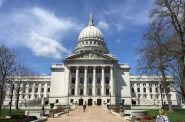 Apr 4th, 2024 by Bruce Murphy
Apr 4th, 2024 by Bruce Murphy
-
Associated Press Will Decline in Wisconsin
 Mar 27th, 2024 by Bruce Murphy
Mar 27th, 2024 by Bruce Murphy
-
City Attorney Race Is Vitally Important
 Mar 25th, 2024 by Bruce Murphy
Mar 25th, 2024 by Bruce Murphy


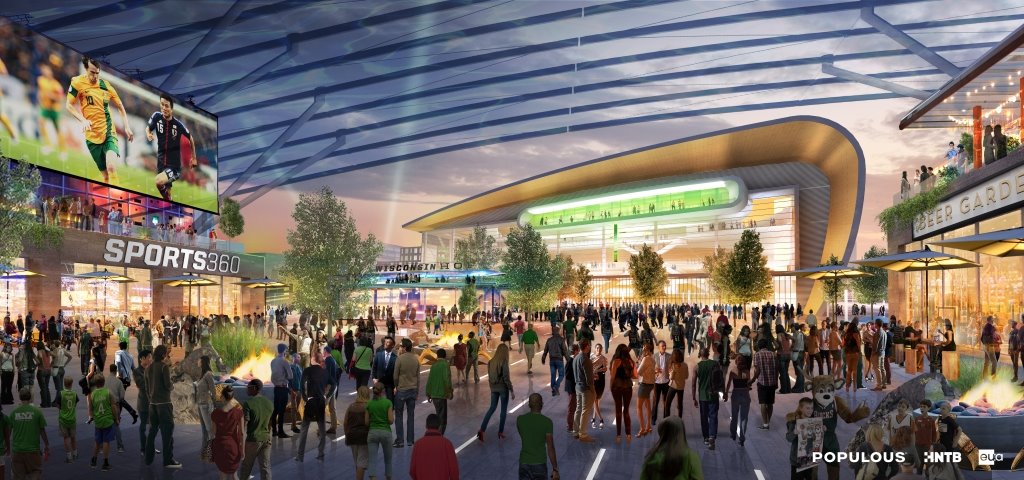
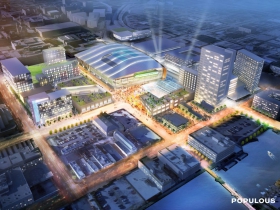
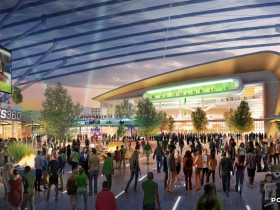
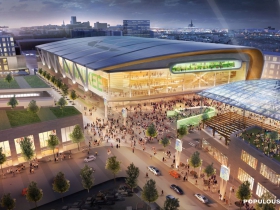















I really don’t disagree with the premise of this article, but I still hope the Bucks get the subsidy. That land has sat vacant forever and I think it is wishful thinking that 72 new businesses will somehow spring up there, especially if the Bucks were to leave. In the last month alone something like 15 million dollars in land purchases have taken place in or by Park East, none of which would of happened without the new stadium plan. Land appraised at 600k was purchased for 3 million. I think the effect on local biz is also overstated. The Bucks are planning on bringing a lot of new residents downtown which should increase demand and if we were to lose the Bucks those ticket holders would be gone, as well. Not much other reason to come downtown in the Winter for a lot of people other than the Bucks. When I look at renderings of the plan it doesn’t seem like there is that much commercial space. Obviously it is a lot but the gloom and doom of how it will hurt other biz I don’t really agree with. One other thing I wonder is if the Bucks do leave what would happen to the Bradley Center?
With this situation, I just see 2 pictures in my head, 1 is of the Bucks getting the subsidy and the impressive portrait of what they have said they would build, not to mention whatever other ancillary development occurs. Picture 2 is if the Bucks leave and that area will be even worse off than it is today which is a scary thought. It is hard for me to wrap my head around how picture 2 is better for the city.
I agree…. I want the Bucks to stay and I believe they are good for the region and the state. However, I am concerned about the entertainment district. Since we are 50% investors, I believe the city must have a strong voice in its design and development. I would have loved for the arena to be jammed downtown and for it to utilize the many marginal or vacant buildings for redevelopment. We do neighborhoods well in Milwaukee….. we don’t do downtowns well.
I am glad someone finally came out and said this. I am a supporter for the arena and keeping the Bucks here. My concern comes in for the entertainment district. Having been to 4th Street Live in Louisville, the P&L in KC, and LA Live; I have watched these entertainment districts start off with a large boom and slowly fizzle to the half empty or mostly baron space they are now. Worse, it may push out some very well established and run business on Old World Third street, which in my mind is the quintessential Milwaukee entertainment district for anyone visiting the city. I hope it is scaled back planned well enough to compliment rather than supplement already existing, and successful, districts like Water St and 3rd.
Can’t call it ICE DISTRICT, tho:
http://www.edmontonjournal.com/Simons+District+name+slick+corporate+cold+comfort/11211442/story.html
The issues of the entertainment mall, which would involve voluntary abdication of the city’s parking garage (and decades of free-and-clear revenue for the city), is a separate issue from any office buildings that may be developed in Park East. The Bucks are not promising the latter for at least 10-12 years or longer.
For the next decade or so, Park East will be mostly surface parking lots, a new mega parking garage, and Bucks offices/gym. There may be some housing (about 200-300 units?). However, Park East and the entertainment have all been lumped together because the Bucks have been allowed to control the narrative, just as the city/county/state are pledging to allow them to control 30 acres of prime real estate as the “master developer.”
Now that the visiting venture capitalists been promised 30 acres of free public land, they can afford to pay inflated prices for other nearby real estate to beef up their empire, such as they’ve started to do on Third Street. Sure, some folks will get a bonus ROI by selling to the Bucks, but what’s the benefit for the rest of the businesses and downtown at large? In any case, worrying about Milwaukee’s economy or “urban fabric” is not in the Bucks’ purview. Only increasing their revenue streams matters.
While city officials can’t create “cool” dynamic development, they can try to put the brakes on cannibalization. Instead, city officials here are telling the Bucks “Here, take over all this real estate. We trust you New Yorkers to do what’s best for our city. We know you only have our best interests at heart.” Midwestern “nice.”
All things being equal everyone is a supporter of the bucks staying, what we are all forgetting is the cost. Yes I want the bucks to say, however not even negotiating with them at all is driving me crazy. There is some number where it is ok to keep them but in my opinion the number is not $250 million plus all the additional benefits we are throwing in (free land, no property tax, shared or all the revenue, naming rights). Lets counter with an offer of $100 million (mostly from state in my opinion) and see what happens. If they want anymore than that we can add it to a ticket tax. That is what I would be comfortable offering (as we will mostly state income tax revenue if they leave).
We need to realize that if this deal falls through Kohl’s $100 million and all the costs incurred to date fall in the lap of the Bucks owners, if our elected officials start acting in our best interests we can get something done, just build a new stadium a block away and forget about the entertainment district.
Doesn’t the city have a history of giving land away based on empty promises of additional development and jobs? Whatever happened to Harley relocating their Chicago offices to the Valley across from the Museum?
“The good news is the now-empty Park East land west of the river will be filled in, and if city officials are correct, much of this development will pay property taxes (though we still haven’t seen the legal language, and the Bucks will push for every nickel of tax exemptions they can get).”
How much development will really pay property tax? The language of the draft arena bill is a bear to decipher, but it says Bucks parking operations would be tax exempt.
https://localtvwiti.files.wordpress.com/2015/06/arena-legislation-p1.pdf
About half or more of Park East will be Bucks-controlled surface parking for a decade or so. The new garage, owned by the city with income split 50-50 with the Bucks, will also be tax exempt. Depending on how the new state-chartered authority defines what’s arena-related (it appears that’s not really up to the city or state), the Bucks offices and gym may also be tax exempt. (“Offices” are listed among “arena-related property” in the draft bill.) A housing complex may be the only taxpaying development on 10 Park East acres for a decade. Bradley Center development could all be pie in the sky and no 300-room hotel will be needed unless convention center expands (which seems off the table).
Even in the entertainment mall, not all businesses may pay property tax. Draft bill seems to say businesses with a liquor license will pay property tax. Thus, a Bucks/NBA merch store could be exempt, other retail, a cafe with no liquor, etc. I agree with Matt. No one is really negotiating to get a decent deal for taxpayers.
Any lawyers out there want to analyze this draft bill?
I attended an event recently hosted by the Bucks and they had an upper level person answering questions from the audience. I specifically asked about the involvement of local businesses in the arena and entertainment district. The answer is there was there will be heavy involvement from local business. He pointed out, what I already knew, that there are many local of food and beverage vendors at the Bradley Center currently. Lakefront beer has a strong presence there for example. I want to see the Bartolata, RC, and Lowlands restaurants part of the new development. The article states “Bucks entertainment district … will pick from off-the-shelf national retailers.” According to the Bucks, that is not the case.
Michael, yes, there’s likely to be some local involvement. Large bar/restaurant groups can afford to gamble on locating one more biz in a new mall–maybe with incentives. What about the impact of an oversaturated market on all smaller businesses who’ve sunk all their capital into one business they’ve nurtured? (Greater Downtown essentially functions as one market–from North Ave. to Walker’s Point)
This will not be a level playing field. It’s not the friendly competition of one establishment after another joining to an existing zone, which is organci. It’s more like Wal-Mart moving in–without the lower prices to benefit consumers. Of course the Bucks will promise the moon. Locating a business inside the arena proper (or Miller Park) with guaranteed attendance, for X number of events, is not the same as the external mall Bruce is describing.
From the draft bill released by Rep. Vos recently:
SECTION 56. 229.41 (11g) of the statutes is created to read:
229.41 (11g) “Sports and entertainment arena facilities” means the sports and
entertainment arena, land and structures, including all fixtures, equipment, and
tangible personal property used primarily to support the operation of the sports and
entertainment arena or are functionally related to the sports and entertainment
arena, located within 9 acres of contiguous land and with boundaries determined by
the board of directors. The facilities include the land and may include offices of the
professional basketball team or its affiliate, parking spaces and garages, storage or
loading facilities, access ways, sidewalks, skywalks, plazas, transportation facilities,
and sports team stores located on the land. In addition to the 9 acres of contiguous
land and structures located on the land, “sports and entertainment arena facilities”
also includes land adjacent to the sports and entertainment arena and a parking
structure, owned by the sponsoring municipality, to be constructed on the land by a
professional basketball team or its affiliate in conjunction with the construction of
the sports and entertainment arena
I think this is kind of fear mongering. Sure, there may be a House of Blues or a TGI Fridays built in the new entertainment district, but I don’t believe that’s going to cause Buckheads or Trinity to close. There has to be a balance in a city and there are certain bars/restaurants that tourists like to visit. For instance, when I was in Cleveland recently, I sought out the Hard Rock Café and found several local establishments on the way. If anything, the fact that Cleveland was worthy of a Hard Rock made it seem like a major city, despite being 2/3rds the size of Milwaukee.
And don’t cry for Water Street. RC owns 50% of the establishments over there and he’s what makes the neighborhood what it is, for the most part. He’s not going to lose any late night business to a Joe’s Crab shack unless he lets his own businesses die.
The one threat would be that these places fill the entertainment district and no one goes to them and they eventually fail and sit empty, however that’s when more local businesses will be able to step in and fill that space. I think this article is really putting the horse before the cart.
Simply: If it were true that arenas and stadiums spur economic development in the form of entertainment businesses that attract fans attending sporting events…then paying for and subsidizing that development undercuts that development, because not only is it competition, it’s tax-subsidized competition. If it succeeds, no new, independent businesses are likely to thrive; if it fails, taxpayers are on the hook for wasted investment dollars.
Bruce, what a great article. The proposed entertainment district sounds more like a shopping mall’s franchise group of bars and restaurants, which does not entice me in any way to visit. Your examples of Water Street, Bay View, the 5th Ward, and the 3rd Ward are exactly what draws me to them. I like “ma and pa” owned businesses that vary In size, design, menu and feel. Even though I might try something that isn’t top-rated, I so much more prefer the surprise of each unique business to knowing exactly what California a Kitchen or Cheesecake Factory or Bar Louis has to offer. It is what makes a city desirable! Wish the political decision makers would understand this.
Bravo!
It seems as if Bruce Murphy is to the arena almost what AFP is to the streetcar.
@Eastside I agree with you, but why can’t Milwaukee have both? An entertainment district near the arena with some big name brands (which I personally never frequent) as well as the charm of Bay View. Milwaukee is a big city so I fail to see how this development is going to eat up biz in all pockets of town. If anything, it will encourage people to move downtown increasing demand.
One question I still need an answer to from all the nay-sayers is what will happen if the Bucks leave town to Park East and the Bradley Center?
I fail to see how a “square block or more of bars, restaurants and retail” is going to eat away at other local biz….From what I can tell the vast majority of this thing is the arena, practice facility, outdoor park thing, hotel, residential and parking. Where are these malls full of chains stores everyone keeps talking about?
Those of us that like and appreciate cities prefer the gritty organic nature of Milwaukee’s neighborhoods. My fear is that suburbanites and tourists need clean, sterile and predictable.
Homer Jay, you’ve probably heard the term “false equivalency.” Your best metaphor is to equate Bruce’s in-depth reporting & AFP?
In this story, Bruce Murphy is just the messenger. If you’re disputing these academics’ long-term independent research involving Milwaukee and other major cities, please throw a few contravening facts into the forum here. These two urban planners/professors have no skin in this game, other than their professional integrity. If wanting to encourage and preserve local businesses and neighborhoods is regressive, then we’re all in trouble.
@Patrick Small
There are some assumptions Bruce makes, and coupled with the fact he has been railing against the arena from day 1 its pretty clear where he stands
“all of this development is likely to be cookie-cutter creations based on what generates profits in other cities. If these nine square blocks got developed more slowly. . ., there would be 72 different businesses operating”
“designed to capture every dollar spent by Bucks fans, so that none of it spins off into other parts of the city.”
“The Bucks entertainment district, by contrast, will pick from off-the-shelf national retailers. Rather than locally unique, it will mimic other huge entertainment complexes.”
“Yet, if the huge plan by the Bucks fails or if the arena needs expansion, as inevitably occurs, the team’s billionaire owners will be back to the city, county and state asking for more money, to assure that the same show goes on and on and on.”
I will ask one more time to the nay-sayers:
If the Bucks leave what will happen to the Bradley center and Park East?
@Will I’m not sure if I’m a naysayer or not, but as far the Park East goes it will eventually be developed. NOTE There was in fact another proposal for a mixed-use development at the same time the Bucks put in their bid.
The reason the new entertainment district is being built is that the Bucks currently don’t get any of the revenues from the Old World 3rd St and Water St businesses. This development is to generate more revenues for them.
So something will give in this and it will likely be the existing businesses unless this development is so cool it draws in thousands of visitors that currently don’t come here. If it relies on a cookie cutter approach it’s unlikely extra people will be drawn.
@DaveReid Thanks for the response. What would you project that the new development would be? I would venture nothing more than 100 million. With ancillary development about 1 billion will be spent with this Bucks project. Also, what about the Bradley Center?
Perhaps the Bradley Center could be rehabbed and an NHL team might fill it. I love the Bucks but this plan is horrible for Milwaukeeans.
Will, about Park East: At a town hall meeting the mayor said Park East development is likely to continue apace whether the Bucks stay or not, based on all recent development in that whole area from The Brewery to North End, MSOE, Avenir, etc. Park East is irrelevant to this, except that the Bucks demanded all the free land to increase their revenue streams–as real estate investors without having to invest anything.
Also, re: Bruce quotes noted, the Bucks told the city that 75% of businesses in their mall with be national chain retailers. That’s not conjecture. Also, it’s now a mandate of the NBA and other sports cartels to “capture every possible dollar” spent by fans. The Bucks mall’s goal is to collect more of that $$ even from non-fans. Fine if they do that in free-market capitalism. Not fair if the public has to give them free land, parking garages, $47 million in cash etc. to do that. None of the deal makers seem to care if small businesses get screwed as a result.
Also, Bruce did not make up that the Bucks will start talking about building a new arena in 20-25 years. That’s the drill now.
As for ancillary development, no one knows what will be developed–only that the Bucks will play broker and make millions on whatever deals they hatch. They’re careful to say they’re only proposing “concepts,” except for the mall and they gym/offices. They know how to make $$ on real estate. All the free land is their HUGE BONUS. They will get a payoff no matter how long it takes to develop those 21 acres. The longer they wait, the more property values will rise. These poker players know when to hold ’em, esp. when taxpayers buy them their chips.
Bruce:
At 67-years-old, the type of “entertainment” center the Bucks are planning are anathema to me. I will never subject myself to the artificial brand of “fun” manufactured at these types of establishments. Yet, I am still a supporter of a new arena for the Bucks. Simply stated, the future Bucks, in my estimation, will be a very good basketball team. When that happens, fans will flock to the new stadium. My proof: the Milwaukee Brewers attendance when they started to make the playoffs. Go Bucks!
Bruce:
Given my relatively advanced age, it is unlikely I will ever set foot in the “entertainment” district planned by the Bucks. Still, I am an avid supporter of the Bucks arena. Why? Simply, the Milwaukee Bucks of the future will be, in my estimation, a very good basketball team. When that happens, Milwaukeeans (and others) will flock to the new stadium. My evidence: look at the attendance figures for the Brewers when they broke through and made the playoffs. We will back a winner, and the Bucks are on the cusp of becoming one. That should be here in Milwaukee, not Seattle or Vegas.
@ Marie
thanks for the response. A couple things tho:
“the mayor said Park East development is likely to continue apace whether the Bucks stay or no”
I get that the city would try to fill PE in the event the Bucks leave town. The question is what would be placed in Park East if the Bucks were to leave. From what I understand the land is pretty much useless as it stands today because it will cost 8 million to get it ready for development. That’s why the other offer PE had also wanted the land for 1 dollar.
“As for ancillary development, no one knows what will be developed–only that the Bucks will play broker and make millions on whatever deals they hatch”
If you think making millions is a sure thing I recommend you head down to Miami and go to a baseball game there. All of their commercial space is empty. The Bucks owners are taking a risk.
“it’s now a mandate of the NBA and other sports cartels to “capture every possible dollar” spent by fans”
Is this your opinion or has this been stated by the NBA? Source?
“Bruce did not make up that the Bucks will start talking about building a new arena in 20-25 years. That’s the drill now. ”
Based on what evidence is that the drill? Didn’t the Bucks sign a 30 year lease?
“As for ancillary development, no one knows what will be developed”
I think it is pretty clear a lot of ancillary development is going to happen. If you want to be very very cynical you could doubt it, but all along that has been the plan.
Also, Marie what do you think would happen to the Bradley Center if the Bucks left?
@Observer
“Perhaps the Bradley Center could be rehabbed and an NHL team might fill it. . . this plan is horrible for Milwaukeeans.”
See, these are the pie in the sky things people say when I ask what will happen to the Bradley Center. So you want to spend 50 million renovating the BC in hopes of getting an NHL team? How is that any better than proceeding with the Bucks plan?
If someone could give me a reasonable guess as to what would happen with the BC it would be the first I’ve heard of one. Any takers?
If I may remind @Greg that the Brewer’s are not an unabashed market success. To this day, some two decades later, from a tax that was to sunset with the completion of the Stadium, the sales tax continues to deliver $22 million annually to the Brewers. Why do they need that kind of subsidy? And, if we are to invest in the Bucks, as a public, did anyone present to us the risk/benefits that we should expect? After all the many years of hostage-taking sports-development in other cities, it is no longer impossible to make reasonable calculations.
Milwaukeeans aren’t the only ones pointing out the folly of these sports arena developments. This brilliant, well-researched examination of public funding of sports venues by comedian John Oliver includes Milwaukee Bucks references at 9:30 & beyond, and Mayor Barrett at a hearing.
https://youtu.be/xcwJt4bcnXs
Bill:
You are absolutely correct about the 4-county sales tax. However, I believe you forgot to mention that, after years of projections that the tax would be further extended, it is now believed that the tax will sunset earlier than recent projections. Bill, would you seriously want to see the Brewers move as well as the Bucks? It is a mystery to me why the Packers never seem to break a sweat when they need funds for expanding Lambeau Field. (By the way, Milwaukee saved that franchise in the mid-20th century, and we were rewarded by seeing 3 home games removed). Can’t we be there for our teams, as well?
https://www.youtube.com/watch?v=xcwJt4bcnXs
Oliver lays it out.
@Will,
Thanks for the follow-up. Some responses..
Sports cartels often talk about “capturing” all income possible, including outside a venue. One team prez clearly outlines that MO in a John Oliver segment, a brilliant (and hilarious) overview of stadium funding. https://www.youtube.com/watch?v=xcwJt4bcnXs
Locally, Peter Feigin told an audience the NBA/Bucks want a huge “footprint” so they can be “as opportunistic as possible,”
http://www.jsonline.com/news/milwaukee/bucks-president-public-financing-needed-to-spur-development-b99421085z1-287697481.html
As for Park East, we only know we’re likely to see a new 1,243-space parking facility, maybe with some housing & retail to disguise the monolith, and a Bucks gym/offices. The state draft bill says Bucks offices may be tax exempt & the parking ramp will be exempt even tho the Bucks (not the arena) will get half the income. No one knows what else will be developed in Park East, promised sometime within 10-12 years “depending on the market” per the Bucks. I don’t see that as great progress.
Re: $1 price. There are always upfront site prep costs. The other recent bidder for PE site may have put a real tax-generating project in the ground much sooner. We’ll never know, since Chris Abele was granted the right by the state to give it away w/o board approval.
I’m not cynical about these developments, just realistic. Bucks reps consistently say they cannot make any promises beyond the “first phase” of development. They also note they may not do any development beyond their digs and maybe the bar mall–they will be the brokers finding the developers (who will, yes, take a risk). There’s zero risk for the Bucks to try to find sub-developers for land they get for free. They will get a cut of the reward with no upfront costs.
As for the Bradley Center: First, I don’t think the Bucks will leave if pols do not capitulate to every one of their brazen demands, including for 30 free acres. The BC would take a hit if the Bucks left, and would need to spend what the state estimates as $16-20M for repairs. MU and Admirals and concerts would continue. I’m not proposing this as a preferred plan. I just don’t buy the “we-gotta-do-whatever-they-demand-or-they’ll-leave” bait. Falling for that has led to a horrid deal for MKE county, city, WCD, etc. Only state might see some benefit.
As others have noted, there’s been no real negotiating except for optics and crumbs. It may be too late to hope for that. Charlie Sykes has made many concrete, realistic suggestions for how to make this deal work for taxpayers and not be mere “corporate welfare” (after he contacted Michael Lewis, author about all things financial). I often don’t agree with Sykes but he nailed this issue and yet the deal has remained virtually unchanged. It’s “Heads the Bucks win. Tails the taxpayers lose.” Alas.
If the Bucks were “owned” like Green Bay is “owned” there would be no uproar over a stadium. We are talking about some the richest individuals in America. As a taxpayer I resent being asked to further enrich them for something probably 96% of all total Milwaukeeans will never enter. Bud Selig first brought up replacing County Stadium with private funding. That changed to public funding that he demanded be spent in a former quarry instead of downtown (Schlitz) where our tax money might have done some good. That soured me on professional sports. Pretty much every report I’ve read notes that it is a scam as far benefits for taxpayers. Now can all of those reports be wrong? See how Cincinnati faired with the money they’ve spent on the Bengals. Let me know where you disagree with this article. http://www.bloomberg.com/news/articles/2013-12-18/cincinnati-stadiums-bury-county-government-in-debt
@Will Where did you get a figure of $50 million for renovations? Are they going install 14K bathroom fixtures? As to what should do with it? Blow it up if the Admirals, UWM, Marquette and concerts could not pay enough rent to rehab it. What exactly needs rehabbing that bad? If the roof leaks, it should take thousands, not millions to put a new roof on. Do the executive suites need updating? Did you read the Bloomberg article?
@Greg, I never said one way or the other whether I want the team to continue to play in Milwaukee on THEIR terms. My opinion on that is not the point. The point is the money they are taking from us, the extension of the “nonprofit” acreage that really is a sham, and the lack of a process that would ask the payers (we, the citizens) what we would like, or what kind of deal would make sense to us. I’d like to believe that we are a democracy and we respect each other even during all the hype about the importance of sports. I don’t think pro sports are all that important (and I get to say that whenever) but I can accommodate differences on this matter.
Having it decided in backrooms and rigged in Madison is not fair to the public. Bob Bauman came up with a deal that I could support, if only because he goes back to Nov. 2008 when citizens voted to give up a property tax and take on a sales tax to fund parks and transit. He modified that bargain a bit to include the arena, but it would raise the $250 million we are pouring into an arena without the benefit of long-term, high value employment. And I say YAY to Bauman’s formula. But the plan is rigged right now to make a certain man appear successful for an audience with values I do not share.
@Greg, your other point about the sunset on the Stadium. The original sunset was to be in a few years. Then it got extended, more than once. If you can recall when someone named an earlier sunset, I won’t argue the point. But it’s been two decades of not abiding with the original agreement. And the clever wording of this agreement reminds me to remind everyone that all that happened back then and we still do not have adequate transit, parks and schools.
Specifically: The $22 million per year goes to 88 expensive games. That’s um, let’s see, $250,000 per ball game, and there are empty seats and the residents who cannot afford a ticket or two are not even invited to fill them. Yeah, whatta deal. Held up and locked out.
Excellent commentary, Bruce. With all the focus on getting the arena funded, no one (other than you) has discussed the possible deleterious consequences of the proposed entertainment district. I visited Kansas City a few years ago and the Power and Light District was a sad, uninteresting place to hang out. People want authenticity. See the following article from the Kansas City Enquirer for a similar perspective. I especially like the line which reads; “Make little plans. Lots of them. And string them together over time. Create cities that grow organically” because that is how you bring life back to a city. Actually, that kind of growth is happening every day in neighborhoods all over Milwaukee and it is being done on a shoe string. Imagine if neighborhood developers could get access to just a small slice of the subsidy that is going to the arena project.
This is from an article by Nalini Johnson in the June 10, 2012 issue of Kansas City Examiner:
Charles Marohn, P.E., AICP based in Minnesota, thinks that “entertainment districts” are overrated. According to Marohn, “It may be too early to tell, but it appears as if entertainment districts may be the new Bilbao Anomaly. Paris and Florence don’t have entertainment district(s). Neither does San Francisco. Melbourne doesn’t either. What these cities have are spaces for people. They also have sports stadiums and bars – just not as the focal points of their city centers or of their new infrastructure investments. The problem boils down to over something very simple: We are disconnecting our downtowns from all other aspects of life when we attempt to turn them into ‘entertainment districts’” (emphasis mine).
We need to be smarter when it comes to land use. People don’t live in boxes, at least they really don’t want to. They want to relate to their environment in a more spontaneous way. People want to bump into things out there, not just be herded into areas with like-minded people. How boring. And the parking lots. Don’t get me started.
Grandiose plans that cannot be completed due to time or financing constraints can become burdens for taxpayers to bear. I suggest applying an age-old planning principle in reverse. Make little plans. Lots of them. And string them together over time. Create cities that grow organically. Provide tools for existing and new owners of smaller tracts to enhance their locations through area plans, rather than assembling large tracts of land to create silver bullets that end up becoming duds. That’s how you bring life back to a city.
Leo, I agree that people want what’s real and local. These packaged fun factories try to manufacture authenticity, which is near impossible. They also create a “penned-in” scene–some say to try to make it feel “safe” for suburbanites to come downtown. People already find come downtown for fun, but for something that interests them, like a touring concert, Bastille Days (it was mobbed), all the festivals, twice-weekly free concerts, night markets, etc. Few will make a trip downtown just to hang out in a mall with 75% chains. The bar mall will pick off some business before or after an arena event, but will likely be ghostly when there’s no big event, which is how several writers have described KC Live! on an off night.
Here’s what Rob Hunden wrote about these malls in a recent report on downtown MKE hospitality:
“As in all Cordish Live! districts, there are built-in controls for public safety and security, such as dress codes
and monitored entrances and exits. However, to allow for a free-flowing crowd, there is a single liquor license
for alcohol that allows patrons to move from place to place with open drinks. Additionally, there are age limits,
typically 21 and up after certain hours, although all ages are allowed at the restaurants within the attraction
and at the summer concert series. Power Plant Live! has been very successful, according to both the developer
and downtown stakeholders and has helped downtown Baltimore become an improved live/work/play district.”
A city official says the Bucks are not planning a fully gated entry system, but the Bucks say their models are these “Live!” malls. These dress codes seem “coded” to me in more ways than one–which I find concerning. Overall, bar malls attempt to replicate Disney World and keep patrons “captive” in a closed environment. But Disney succeeds for reasons too numerous to mention, while these malls are sad wannabes. Even Hunden, a “destination” consultant, acknowledges they often fail and that blandness is a common problem.
The Common Council will vote on this in September. Most of the city’s direct and indirect subsidies–over $100 million by my count–will go to support this for-profit enterprise that is completely separate from the arena. The council and mayor (who’s over the moon on this mall) need to hear what people think of it.
This recent article analyzes the history of Kansas City Live in detail, as well as recent public subsidies to developer Cordish for upscale apartments in KC, past when any incentives are warranted.
https://nextcity.org/features/view/kansas-city-mall-downtown-development-subsidies-cordish-companies
What a great link, Virginia. “The nearly $15 million the city spent repaying Power & Light District debt in 2014 was money it couldn’t spend on public libraries, parks, police, blight cleanup and other public services — no small sacrifice in a city that had a general operating budget of $1.42 billion that year. The debt isn’t going away anytime soon either; last year, the city refinanced, which lowered the payments from 2015 through 2019 but extended the debt schedule from 2033 to 2040. “I don’t think there will be a point at any time in the foreseeable future, probably the next 20 years, where it actually pays for itself,” City Manager Troy Schulte told the Star in February.”- Socialism lives, but it isn’t the same socialism that Victor Berger, Emil Seidel, Daniel Hoan or Frank Zeidler envisioned. I notice that WCD was very much against this boondoggle early on, as were many progressives, but since Wisconsin’s conservative powers that be have come out for this project, he’s been sort of silent. What’s up Bob?
Observer, socialism in service to sports cartels is bad enough. But messing with the free marketplace by creating cartel-mandated “entertainment monopolies” is beyond the pale. Those desperate folks in Kansas City were willing to try anything and pay any public subsidy to bring some bodies downtown. Some consultant fed them some inflated figures and they got snookered. But Milwaukee’s luring plenty of bodies to Third, Water, Jefferson, Brady, etc. and all the rest. Only the Bucks are demanding this bar mall.
The end of the Next City article talks about another KC district that evolved organically and city officials are wise enough to try to help it survive–rather than killing the goose laying the golden egg. At the very least, MKE can avoid spending tens of millions on something others build out of desperation. We’re better than that and just don’t know it. But extortion can make even smart people compliant.
Did anyone forget, or even knows who Mike Fascitelli {spell check) and Wes Edens are?? We’re talk’n major New York city developers here!! Off the shelf retailers means a different thing than what local Milwaukeans or Wisconsinites are used too… I don’t think they will only add “Pizza Huts” and “Best Buys” to the district… I’m think’n more along the lines of “ESPN Zones” and the like as well….
And yes, I wouldn’t be surprised to see a couple more High Rise residential towers go up… We already have Dallas, Chicago, Atlanta, and New York City investors here throw’n up developments….
Don’t see this thing thru a narrow lense… The broader goal here is to make Milwaukee a tourist attraction, and I also think that the entertainment district will add more jobs and things to do in “Milwaukee” that will curb or lessen the city’s current #6 position for the most dangerous cities in America… Sad to say, but the majority of that is due to abandoned adolescent African Americans with idol minds…. Stop think’n with selfish ambition of what will draw just “You”{who are mainly not Black adolescents) to the city….
See what I see, and that’s an opportunity to rebuild Milwaukee as a whole…. I believe in the force behind the drive, not just one specific faction….